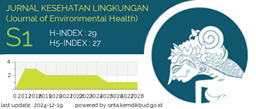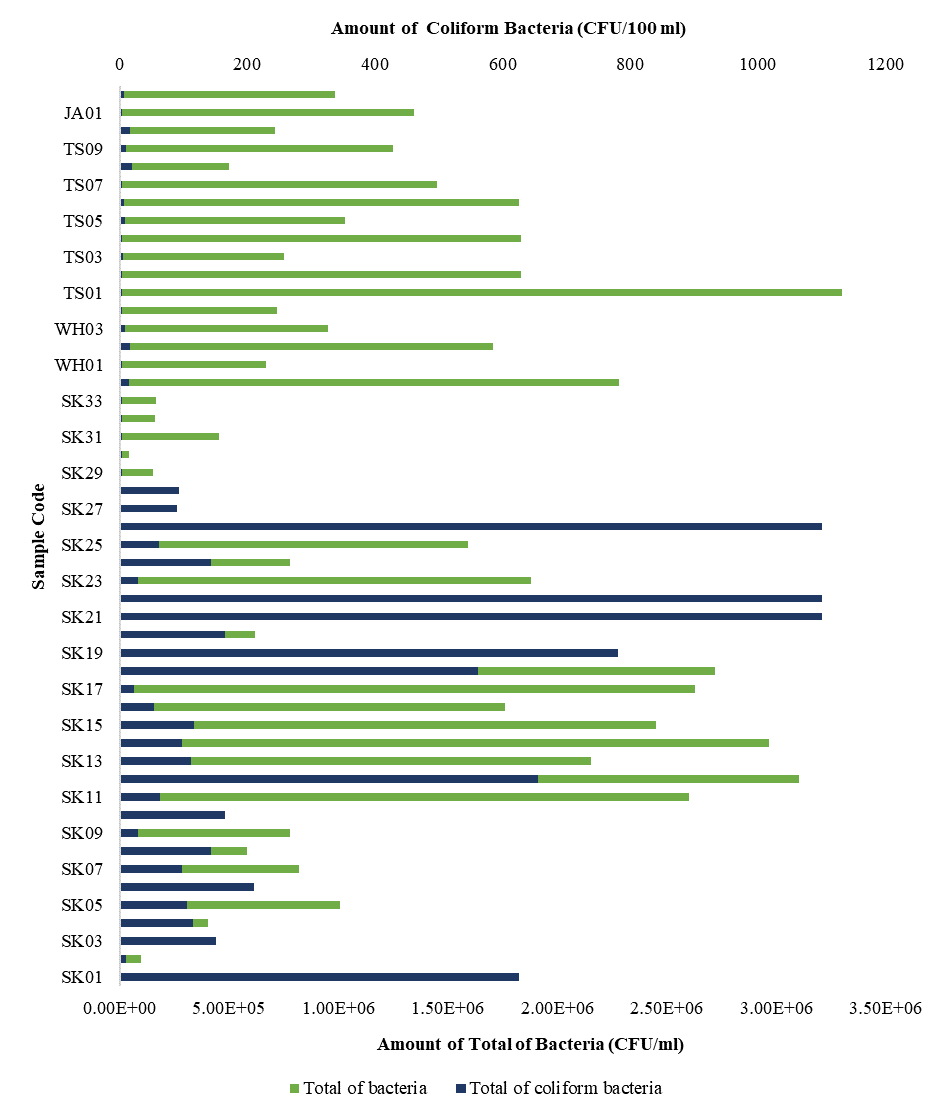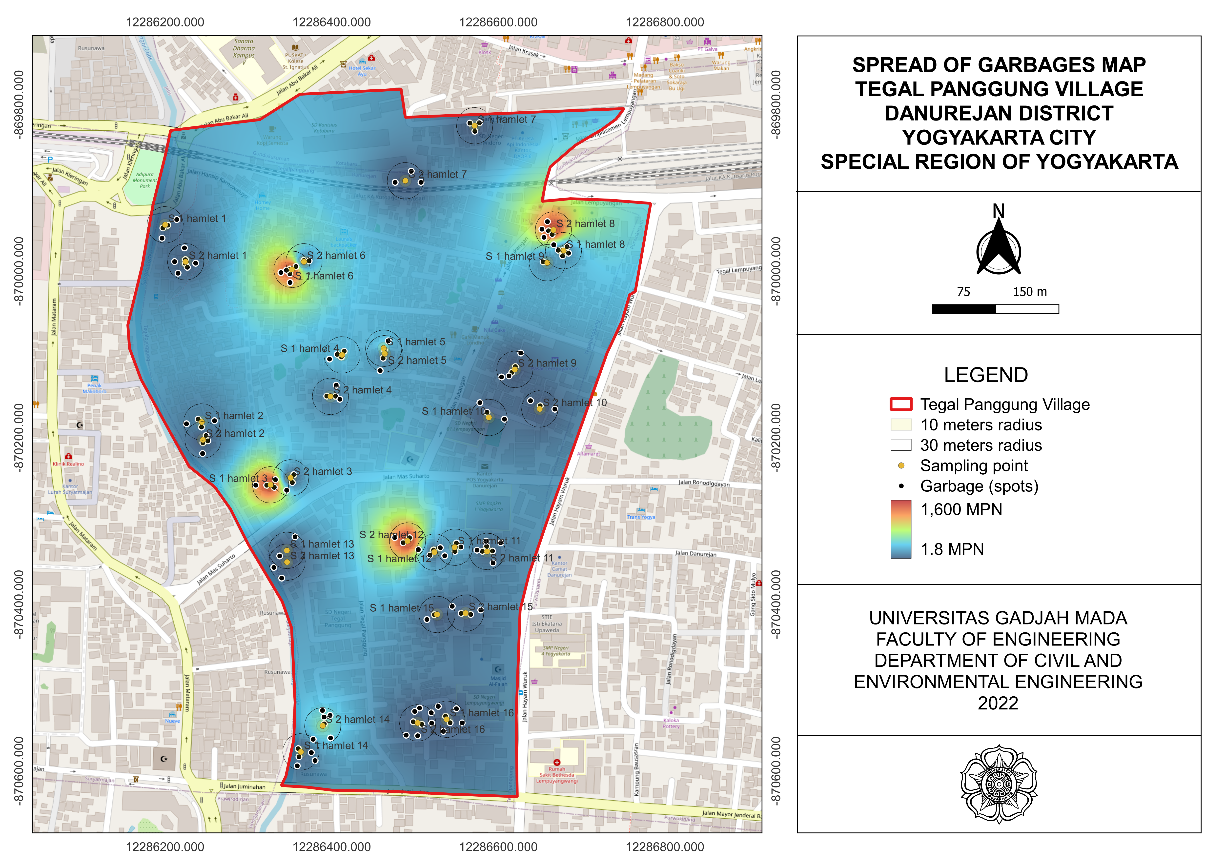Occurrence and Consumer Health Risk Assessment of Heavy Metals in Frozen Demersal Fish and Cephalopod Products from Benoa Port, Bali Province

Introduction: Heavy metal pollution has become an important environmental issue today. This study was aimed to identify the heavy metals of the two fishing products namely demersal fish and cephalopods landed at Benoa Port, Bali Province and their health risk effects on consumers. Methods: Demersal fish and cephalopod products were obtained from local fishermen at Benoa port. Atomic Absorption Spectrophotometry (AAS) was used to specify the (Pb, Cd, and Hg) in 34 fish fillet products weighing an average of 500 grams each. Statistical software was used to conduct an analysis of the collected data, while THQ, TTHQ, and TCR were calculated and compared with USEPA regulations. Results and Discussion: The results of this research showed that the content of heavy metals in demersal fish and cephalopod products was lower than the levels suggested by official agencies in a number of countries. In populations of various ages, the target Hazard Quotient (THQ) for the heavy metal was less than 1. At this point, the Total THQ result did not imply any risk to human health from ingestion of these two fishery products. When these two products were ingested, the target cancer risk (TCR) did not represent a cancer risk. Conclusion: The outcomes of this study showed that the bioaccumulation levels of both fishery products with low levels of heavy metals are safe for human consumption.
Ababouch L, Nguyen KAT, Castro de Souza M, Fernandez"Polanco J. Value Chains and Market Access for Aquaculture Products. J World Aquac Soc. 2023;54(2):527–553. https://doi.org/10.1111/jwas.12964
Lindsay AR. Nutritional Implications of International Fishing and Trade. Proc Natl Acad Sci. 2022;119(26):e2206587119. https://doi.org/10.1073/pnas.2206587119
Bennett A, Basurto X, Virdin J, Lin X, Betances SJ, Smith MD, et al. Recognize Fish as Food in Policy Discourse and Development Funding. Ambio. 2021;50(5):981–989. https://doi.org/10.1007/s13280-020-01451-4
Egger A, Ahern M. The State of World Fisheries and Aquaculture 2022. FAO; 2022. https://doi.org/10.4060/cc0461en
Food and Agriculture Organization of United States. The State of World Fisheries and Aquaculture 2020. United States: Food and Agriculture Organization of United States; 2020. https://doi.org/10.4060/ca9229en
Wiradana PA, Widhiantara IG, Pradisty NA, Mukti AT. The Impact of Covid19 on Indonesian Fisheries Conditions: Opinion of Current Status and Recommendations. IOP Conf Ser Earth Environ Sci. 2021;718(012020):1-10. https://doi.org/10.1088/1755-1315/718/1/012020
Nieman CM, Rudman AN, Chory ML, Murray GD, Fairbanks L, Campbell LM. Fishing for Food: Values and Benefits Associated with Coastal Infrastructure. PLoS One. 2021;16(4):e0249725. https://doi.org/10.1371/journal.pone.0249725
Coppola D, Lauritano C, Palma Esposito F, Riccio G, Rizzo C, de Pascale D. Fish Waste: from Problem to Valuable Resource. Mar Drugs. 2021;19(2):116. https://doi.org/10.3390/md19020116
Tilami SK. Nutritional Value of Fish: Lipids, Proteins, Vitamins, and Minerals. Rev Fish Sci Aquac. 2018;26(2):243–253. https://doi.org/10.1080/23308249.2017.1399104
Freitas R, Campos MM. Protective Effects of Omega-3 Fatty Acids in Cancer-Related Complications. Nutrients. 2019;11(5):945. https://doi.org/10.3390/nu11050945
Kuszewski JC, Wong RHX, Howe PRC. Fish Oil Supplementation Reduces Osteoarthritis-Specific Pain in Older Adults with Overweight/Obesity. Rheumatol Adv Pract. 2020;4(2):1-9. https://doi.org/10.1093/rap/rkaa036
Cucchi D, Camacho-Muñoz D, Certo M, Niven J, Smith J, Nicolaou A, et al. Omega-3 Polyunsaturated Fatty Acids Impinge on CD4+ T Cell Motility and Adipose Tissue Distribution Via Direct and Lipid Mediator-Dependent Effects. Cardiovasc Res. 2019;116(5):1006-1020 https://doi.org/10.1093/cvr/cvz208
Ryu B, Shin K-H, Kim S-K. Muscle Protein Hydrolysates and Amino Acid Composition in Fish. Mar Drugs. 2021;19(7):377. https://doi.org/10.3390/md19070377
Lall SP, Kaushik SJ. Nutrition and Metabolism of Minerals in Fish. Animals. 2021;11(9):2711. https://doi.org/10.3390/ani11092711
Miri M, Aval HE, Ehrampoush MH, Mohammadi A, Toolabi A, Nikonahad A, et al. Human Health Impact Assessment of Exposure to Particulate Matter: An AirQ Software Modeling. Environ Sci Pollut Res. 2017;24(19):16513–16519. https://doi.org/10.1007/s11356-017-9189-9
Fakhri Y, Mohseni-Bandpei A, Oliveri Conti G, Ferrante M, Cristaldi A, Jeihooni AK, et al. Systematic Review and Health Risk Assessment of Arsenic and Lead in the Fished Shrimps from the Persian Gulf. Food Chem Toxicol. 2018;113(1):278–286. https://doi.org/10.1016/j.fct.2018.01.046
Balali-Mood M, Naseri K, Tahergorabi Z, Khazdair MR, Sadeghi M. Toxic Mechanisms of Five Heavy Metals: Mercury, Lead, Chromium, Cadmium, and Arsenic. Front Pharmacol. 2021;12(643972):1-19. https://doi.org/10.3389/fphar.2021.643972
Ding C, Chen J, Zhu F, Chai L, Lin Z, Zhang K, et al. Biological Toxicity of Heavy Metal(loid)s in Natural Environments: From Microbes to Humans. Front Environ Sci. 2022;10(920957):1-23. https://doi.org/10.3389/fenvs.2022.920957
McCarty LS, Borgert CJ, Burgoon LD. Evaluation of the Inherent Toxicity Concept in Environmental Toxicology and Risk Assessment. Environ Toxicol Chem. 2020;39(12):2351–2360. https://doi.org/10.1002/etc.4881
Mitra S, Chakraborty AJ, Tareq AM, Emran T Bin, Nainu F, Khusro A, et al. Impact of Heavy Metals on the Environment and Human Health: Novel Therapeutic Insights to Counter the Toxicity. J King Saud Univ - Sci. 2022;34(3):101865. https://doi.org/10.1016/j.jksus.2022.101865
Sodhi KK, Mishra LC, Singh CK, Kumar M. Perspective on the Heavy Metal Pollution and Recent Remediation Strategies. Curr Res Microb Sci. 2022;3(100166):1-10. https://doi.org/10.1016/j.crmicr.2022.100166
Rahman MS, Ahmed Z, Seefat SM, Alam R, Islam ARMT, Choudhury TR, et al. Assessment of Heavy Metal Contamination in Sediment at the Newly Established Tannery Industrial Estate in Bangladesh: A Case Study. Environ Chem Ecotoxicol. 2022;4(1):1–12. https://doi.org/10.1016/j.enceco.2021.10.001
Oktariani AF, Sudaryatma PE, Ramona Y, Wirasuta IMG, Darmayasa IBG, Wiradana PA, et al. Heavy Metals Content in Fresh Tuna and Swordfish Caught from Hindian and Pacific Oceans: Health Risk Assessment of Dietary Exposure. Vet World. 2023;16(4):858–868. https://doi.org/10.14202/vetworld.2023.858-868
Zamora-Ledezma C, Negrete-Bolagay D, Figueroa F, Zamora-Ledezma E, Ni M, Alexis F, et al. Heavy Metal Water Pollution: A Fresh Look About Hazards, Novel and Conventional Remediation Methods. Environ Technol Innov. 2021;22(101504):1-26. https://doi.org/10.1016/j.eti.2021.101504
Gu Y-G, Ning J-J, Ke C-L, Huang H-H. Bioaccessibility and Human Health Implications of Heavy Metals in Different Trophic Level Marine Organisms: A Case Study of the South China Sea. Ecotoxicol Environ Saf. 2018;163(1):551–557. https://doi.org/10.1016/j.ecoenv.2018.07.114
Obayemi OE, Ayoade MA, Komolafe OO. Health Risk Assessment of Heavy Metals in Coptodon zillii and Parachanna obscura from a Tropical Reservoir. Heliyon. 2023;9(6):e16609. https://doi.org/10.1016/j.heliyon.2023.e16609
Sethi R, Molfetta AD. Human Health Risk Assessment. In Groundwater Engineering. Springer Tracts in Civil Engineering. Switzerland: Springer Cham; 2019. p 301–329. https://doi.org/10.1007/978-3-030-20516-4_16
Arisekar U, Shakila RJ, Shalini R, Jeyasekaran G. Human Health Risk Assessment of Heavy Metals in Aquatic Sediments and Freshwater Fish Caught from Thamirabarani River, the Western Ghats of South Tamil Nadu. Mar Pollut Bull. 2020;159(111496):1-10. https://doi.org/10.1016/j.marpolbul.2020.111496
Shalini R, Jeyasekaran G, Shakila RJ, Sundhar S, Arisekar U, Jawahar P, et al. Dietary Intake of Trace Elements from Commercially Important Fish and Shellfish of Thoothukudi along the Southeast Coast of India and Implications for Human Health Risk Assessment. Mar Pollut Bull. 2021;173(113020):1-8. https://doi.org/10.1016/j.marpolbul.2021.113020
Rabia SH, Luzardo OP, Pozo R, Abbassy M, Zumbado M, Elalfy I, et al. Determination of Heavy Metals from Aloe vera by- Product in Golden Mullet (Liza aurata); A Consumer Health Risk Assessment. Food Chem Toxicol. 2022;169(113418):1-9. https://doi.org/10.1016/j.fct.2022.113418
Monier MN, Soliman AM, Al-Halani AA. The Seasonal Assessment of Heavy Metals Pollution in Water, Sediments, and Fish of Grey Mullet, Red Seabream, and Sardine from the Mediterranean Coast, Damietta, North Egypt. Reg Stud Mar Sci. 2023;57(102744):1-11. https://doi.org/10.1016/j.rsma.2022.102744
Rosiana IW, Wiradana PA, Permatasari AAAP, Pelupessy YAEG, Dame MVO, Soegianto A, et al. Concentrations of Heavy Metals in Three Brown Seaweed (Phaeophyta: Phaeophyceae) Collected from Tourism Area in Sanur Beach, Coast of Denpasar, Bali and Public Health Risk Assessment. J Ilm Perikan dan Kelaut. 2022;14(2):327–339. https://doi.org/10.20473/jipk.v14i2.33103
Sarah R, Tabassum B, Idrees N, Hashem A, Abd_Allah EF. Bioaccumulation of Heavy Metals in Channa Punctatus (Bloch) in River Ramganga (U.P.), India. Saudi J Biol Sci. 2019;26(5):979–984. https://doi.org/10.1016/j.sjbs.2019.02.009
Monikh FA, Safahieh A, Savari A, Doraghi A. Heavy metal concentration in sediment, benthic, benthopelagic, and pelagic fish species from Musa Estuary (Persian Gulf). Environ Monit Assess. 2013;185(1):215–222. https://doi.org/10.1007/s10661-012-2545-9
Wasilah QA, Mawli RE, Sani MD, Soegianto A, Wiradana PA, Pradisty NA. Determination of Lead and Cadmium in Edible Wedge Clam (Donax faba) Collected from North and South Coasts of Sumenep, East Java, Indonesia. Poll Res. 2021;40(2):593–597. http://www.envirobiotechjournals.com/article_abstract.php?aid=11523&iid=332&jid=4
Khellaf B, Bouayad L, Benouadah A, Hamdi TM, Chekri R, Jitaru P. Arsenic, Mercury, Cadmium and Lead Contents in Algerian Continental and Marine Farming Fish and Human Health Risk Assessment Due to Their Consumption. Reg Stud Mar Sci. 2023;62(102943):1-10. https://doi.org/10.1016/j.rsma.2023.102943
Grassi G, Simonetti A, Gambacorta E, Perna A. Decrease of Activity of Antioxidant Enzymes, Lysozyme Content, and Protein Degradation in Milk Contaminated with Heavy Metals (Cadmium and Lead). JDS Commun. 2022;3(5):312–316. https://doi.org/10.3168/jdsc.2022-0222
Banaee M, Beitsayah A, Prokić MD, Petrović TG, Zeidi A, Faggio C. Effects of Cadmium Chloride and Biofertilizer (Bacilar) on Biochemical Parameters of Freshwater Fish, Alburnus mossulensis. Comp Biochem Physiol Part C Toxicol Pharmacol. 2023;268(109614):1-7. https://doi.org/10.1016/j.cbpc.2023.109614
Lee J-W, Choi H, Hwang U-K, Kang J-C, Kang YJ, Kim K Il, et al. Toxic Effects of Lead Exposure on Bioaccumulation, Oxidative Stress, Neurotoxicity, and Immune Responses in Fish: A Review. Environ Toxicol Pharmacol. 2019;68(1):101–108. https://doi.org/10.1016/j.etap.2019.03.010
Vieira JCS, Braga CP, Queiroz JV de, Cavecci-Mendonça B, Oliveira G de, Freitas NG de, et al. The Effects of Mercury Exposure on Amazonian Fishes: An Investigation of Potential Biomarkers. Chemosphere. 2023;316(137779):1-13. https://doi.org/10.1016/j.chemosphere.2023.137779
Groves BM, Whitbeck EJ, Henderson F. Methods of Removing Heavy Metals from Food Products. United States: World Intellectual Property Organization; WO2012009234A2, 2012. https://patents.google.com/patent/WO2012009234A2/en
Akter S, Jahan N, Rohani MF, Akter Y, Shahjahan M. Chromium Supplementation in Diet Enhances Growth and Feed Utilization of Striped Catfish (Pangasianodon hypophthalmus). Biol Trace Elem Res. 2021;199(12):4811–4819. https://doi.org/10.1007/s12011-021-02608-2
Li X, Liang H, Zeng Y, Zheng X, Ren Z, Mai B. Trophic Transfer of Heavy Metals in A Wetland Food Web from an Abandoned E-Waste Recycling Site in South China. Sci Total Environ. 2023;890(164327):1-8. https://doi.org/10.1016/j.scitotenv.2023.164327
Gall JE, Boyd RS, Rajakaruna N. Transfer of Heavy Metals Through Terrestrial Food Webs: A Review. Environ Monit Assess. 2015;187(4):201. https://doi.org/10.1007/s10661-015-4436-3
Gao Y, Wang R, Li Y, Ding X, Jiang Y, Feng J, et al. Trophic Transfer of Heavy Metals in the Marine Food Web Based on Tissue Residuals. Sci Total Environ. 2021;772(145064):1-12. https://doi.org/10.1016/j.scitotenv.2021.145064
Mahenda AA, Wiradana PA, Susilo RJK, Soegianto A, Ansori ANM, Pradisty NA. Relationship of Water Quality with Phytoplankton Abundance in Kenjeran Coastal Waters, Surabaya, East Java, Indonesia. Pollut Res. 2021;40(2):515–521. http://www.envirobiotechjournals.com/article_abstract.php?aid=11511&iid=332&jid=4
Watiniasih NL, Hendrawan IG, Nuarsa IW, Wiradana PA. Investigation of Microplastic Contamination in Sediments, Water and Aquatic Biota in Lake Beratan, Tabanan Regency, Bali Province – Indonesia. J Ecol Eng. 2023;24(3):323–332. https://doi.org/10.12911/22998993/158819
Mohammadi M, Askary Sary A, Khodadadi M. Determination of Heavy Metals in Two Barbs, Barbus grypus and Barbus xanthopterus in Karoon and Dez Rivers, Khoozestan, Iran. Bull Environ Contam Toxicol. 2011;87(2):158–162. https://doi.org/10.1007/s00128-011-0302-3
Tuzen M. Toxic and Essential Trace Elemental Contents in Fish Species from the Black Sea, Turkey. Food Chem Toxicol. 2009;47(8):1785–1790. https://doi.org/10.1016/j.fct.2009.04.029
Jezierska B, Åugowska K, Witeska M. The Effects of Heavy Metals on Embryonic Development of Fish (A Review). Fish Physiol Biochem. 2009;35(4):625–640. https://doi.org/10.1007/s10695-008-9284-4
Parab V, Prajapati JJ, Karan S, Bhowmick AR, Mukherjee J. Impact of Abiotic Factors and Heavy Metals in Predicting the Population Decline of Near Threatened Fish Notopterus chitala in Natural Habitat. Aquat Ecol. 2023;57(4):863–879. https://doi.org/10.1007/s10452-022-09995-1
Kortei NK, Heymann ME, Essuman EK, Kpodo FM, Akonor PT, Lokpo SY, et al. Health Risk Assessment and Levels of Toxic Metals in Fishes (Oreochromis noliticus and Clarias anguillaris) from Ankobrah and Pra basins: Impact of Illegal Mining Activities on Food Safety. Toxicol Reports. 2020;7(1):360–369. https://doi.org/10.1016/j.toxrep.2020.02.011
Li J, Miao X, Hao Y, Xie Z, Zou S, Zhou C. Health Risk Assessment of Metals (Cu, Pb, Zn, Cr, Cd, As, Hg, Se) in Angling Fish with Different Lengths Collected from Liuzhou, China. Int J Environ Res Public Health. 2020;17(7):2192. https://doi.org/10.3390/ijerph17072192
Hossain MB, Bhuiyan NZ, Kasem A, Hossain MK, Sultana S, Nur A-AU, et al. Heavy Metals in Four Marine Fish and Shrimp Species from a Subtropical Coastal Area: Accumulation and Consumer Health Risk Assessment. Biology. 2022;11(12):1780. https://doi.org/10.3390/biology11121780
Gebeyehu HR, Bayissa LD. Levels of Heavy Metals in Soil and Vegetables and Associated Health Risks in Mojo area, Ethiopia. PLoS One. 2020;15(1):e0227883. https://doi.org/10.1371/journal.pone.0227883
Adegbola IP, Aborisade BA, Adetutu A. Health Risk Assessment and Heavy Metal Accumulation in Fish Species (Clarias gariepinus and Sarotherodon melanotheron) from Industrially Polluted Ogun and Eleyele Rivers, Nigeria. Toxicol Reports. 2021;8(1):1445–1460. https://doi.org/10.1016/j.toxrep.2021.07.007
Traina A, Bono G, Bonsignore M, Falco F, Giuga M, Quinci EM, et al. Heavy Metals Concentrations in Some Commercially Key Species from Sicilian coasts (Mediterranean Sea): Potential Human Health Risk Estimation. Ecotoxicol Environ Saf. 2019;168(1):466–478. https://doi.org/10.1016/j.ecoenv.2018.10.056
Ahmed MK, Baki MA, Islam MS, Kundu GK, Habibullah-Al-Mamun M, Sarkar SK, et al. Human Health Risk Assessment of Heavy Metals in Tropical Fish and Shellfish Collected from the River Buriganga, Bangladesh. Environ Sci Pollut Res. 2015;22(20):15880–15890. https://doi.org/10.1007/s11356-015-4813-z
Bagheri T, Misaghi A, MirGhaed AT, Kamkar A, Hedayati A, Akbarein H. Health Risk Assessment of Some Heavy Metals Detected in Edible Fishes of Gorgan Bay, Caspian Sea (Iran), for Human. Environ Sci Pollut Res. 2023;30(15):44480–44489. https://doi.org/10.1007/s11356-022-25082-2
Tchounwou PB, Yedjou CG, Patlolla AK, Sutton DJ. Heavy Metal Toxicity and the Environment. In Molecular, Clinical and Environmental Toxicology. Experientia Supplementum, Basel: Springer; 2012. p 133–164. https://doi.org/10.1007/978-3-7643-8340-4_6
Chen R, Xu Y, Xu C, Shu Y, Ma S, Lu C, et al. Associations Between Mercury Exposure and The Risk of Nonalcoholic Fatty Liver Disease (NAFLD) in US Adolescents. Environ Sci Pollut Res. 2019;26(30):31384–31391. https://doi.org/10.1007/s11356-019-06224-5
Santos AAD, Chang LW, Guo GL, Aschner M. Fetal Minamata Disease: A Human Episode of Congenital Methylmercury Poisoning. In: Handbook of Developmental Neurotoxicology. United States: Elsevier; 2018. p 399–406. https://doi.org/10.1016/B978-0-12-809405-1.00035-3
Food and Agriculture Organization of United States. LEGAL NOTICE No 66/2003 Heavy Metals Regulations. United States: Food and Agriculture Organization of United States; 2003.
Gazi E, Kirilmaz B, Simsek HY, Sacar M. PP-143 Giant Left Atrial Myxoma Presenting with Paroxysmal Atrial Fibrillation and Syncope. Int J Cardiol. 2012;155(Sup 1):S149. https://doi.org/10.1016/S0167-5273(12)70361-3
Regional Organization for the Protection of the Marine Environment. State of the Marine Environment Report - 2013 ROPME/GC-16/1-ii. Kuwait: Regional Organization for the Protection of the Marine Environment; 2013. p. 225. www.ropme.org
Food and Drug Administration. Handbook Fish and Fishery Products Hazard and Control Guidance. United States: Department of Health and Human Services; 2021.
Official Journal of European Union. Commission Regulation (EU) 2022/617 Regards Maximum Levels of Mercury in Fish and Salt. Brussels: Official Journal of European Union; 2022.
The National Agency of Drug and Food Control. Maximum Limits of Heavy Metal Contamination in Processed Food. Jakarta: The National Agency of Drug and Food Control; 2018.

This work is licensed under a Creative Commons Attribution-NonCommercial-ShareAlike 4.0 International License.
1. Copyright of all journal manuscripts is held by the Jurnal Kesehatan Lingkungan.2. Formal legal provisions to access digital articles of electronic journal are subject to the provision of the Creative Commons Attribution-ShareAlike license (CC BY-NC-SA), which means that Jurnal Kesehatan Lingkungan is rightful to keep, transfer media/format, manage in the form of databases, maintain, and publish articles.
3. Published manuscripts both printed and electronic are open access for educational, research, and library purposes. Additionally, the editorial board is not responsible for any violations of copyright law.
JKESLING by UNAIR is licensed under a Creative Commons Attribution-ShareAlike 4.0 International License.






































